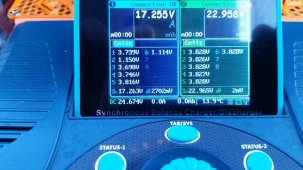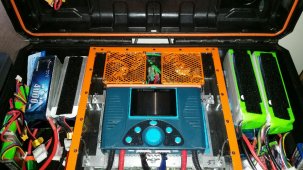LOL, done!
I don't plan for failure, but I do try to plan ahead! I figured at some point I would have some need for a second balance lead on the pack So I built it in from the get!
So you’ve already got a second harness wired in?
If you built it out of the thin wire like the one used for your BMS harness, it’s not going to cut it.
The harness that comes with a 5A Heltec Active Balancer is thicker (suitable for 5A sustained currents).
So unless your ‘extra’ harness is suitable for 5A currents, you’ll need to wire in the harness than cones with your active balancer (which you’ll almost certainly need to do in any case, as the 5A balancer uses a different (larger, higher-current) connector than the connector used by the typical BMS…
I'm kind of leaning towards the balance board over disassembly (still going to read more tonight).
So, with the active balancer, do I want that just near the end of the charge? or wait till the pack is empty and connect it for the whole charge?
I believe I've read that active balancers during bulk can muck things up?
Yes, you’ll have the most success if you only connect the Active Balancer late in the charge cycle when the ‘runner’ cell is well above the ‘knee’.
You can do as I did and only connect the balancer once charging is complete (meaning your BMS has likely disconnected for HVD in your case).
Even if your BMS has disconnected, it will reconnect after it has brought down the runner. If the charger is still connected AVS there is charge current available (sun is still shining), charging will resume until there is another HVD from the runner cell. This should not cause any damage but can result in ‘thrashing’ (repeated HVD / HVR cycles) which I preferred to avoid and so I only connected my active balancer after the sun went down (or after cutting the solar input).
The effectiveness of the balancer is a function of voltage mismatch, so it does pretty much nothing in the ‘flats’.
I believe it delivers dirtying like 1A @ 100mV of mismatch, so you want the runner to be at least 100mV above the other cells for it to have much of any impact at all (meaning the runner needs to be above the charge knee).
Relying on your BMS to disconnect when the runner cell hits HVD is not ‘gentle’ on your system and in general, is not recommended (fail safe only).
A better thing to do is lower your bulk voltage so that your charger moves to Float before your runner has hit HVD.
As an example, if you’ve got 7 cells at 3.36V when your runner hits 3.5V, a bulk/boost voltage of 27.02V should cause the charge controller to stop CC charging before your runner goes much above 3.5V.
Now your charger will move to Float and if you float at a lower voltage like 26.9V, your Active Balancer will remain active while your charge controller remains in float, without your BMS ever disconnecting from HVD.
The two situations you want to avoid are:
-having the active balancer connected while any discharge currents are flowing
-having the active balancer connected when all 8 cells are on ‘the flats’ (you want at least one runner up past the charge Lee before connecting the active balancer).
Currently, I have only the Multiplus hooked up but I am mounting my solar panels literally today and will wait to hook up the mppt's until I know I should
View attachment 67133
Relying on your BMS to protect your cells is not the end of the world, but if you have the time to monitor, the best thing to do would be to:
-go ahead and connect your SCC
-monitor cell voltage to ‘see’ when your runner starts running past the other cells (>3.45V)
-watch it get all the way to the maximum voltage below HVD you are comfortable with (I was comfortable with 3.500V).
-then disconnect the PV to halt charging and connect your active balancer
-just to understand how things are working (and how quickly balance is progressing), once the runner cell has balanced down to within 10-20mV of the others, you can reconnect the PV and monitor / watch it charge back to 3.500V a second time (then disconnect PV again).
Repeating this cycle manually a few times should give you an idea of what voltage settings can be used so that your SCC will hit float and hold there with the PV connected. At that point, you could consider allowing the system to run on ‘automatic’ (though I’d still recommend monitoring, at least until you have confidence in the trend).
If you haven’t yet gotten one, a cell-level monitor is highly, highly recommended:
https://www.amazon.com/ISDT-Battery-Meter,LCD-Capacity-Balancer/dp/B07797N9BG
(And might also make use of your spare harness, though again, it’s a different connector than the standard BMS connector - I made an adapter).




